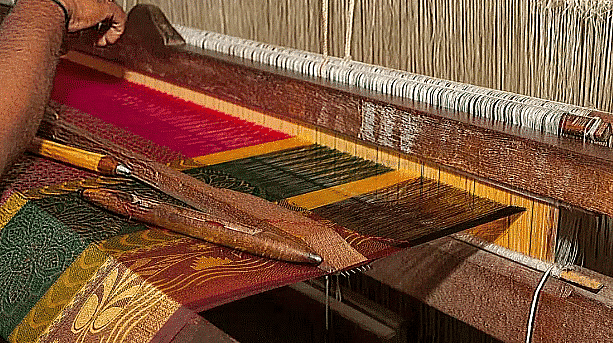Pochampalli - 1 Class 4 Worksheet EVS Chapter 23
Q1: Fill in the Blanks
(i) ________ thread is used to weave cotton sarees.
(ii) Mukhtapur village lies in ________ town.
(iii) Great ______ is needed to weave such special silk sarees.
(iv) Weaving requires ________ work.
(v) Vani and Mukta's home is always filled with bright-colored ________.

Q2: True and False
(i) Big shopkeepers give the weavers very little money for the sarees.
(ii) As most of the families in the town of Pochampalli are weavers so they call the special cloth they weave as Pochampalli.
(iii) Many different things have to be done before the actual weaving.
(iv) The size and the number of needles of the loom remain same for every design.
(v) Vani and Prasad do not get much time to help their parents in the weaving work.
Q3: Short Questions Answer
(i) Name two natural fibers used to make cloth.
(ii) What has made Pochampalli town world famous?

(iii) The famous Madhubani paintings come from which state?
(iv) Give two examples of things that have become famous by the name of the place where they are made.
(v) Why are many weavers leaving their villages to work as laborers in big cities?
(vi) In Vani’s house, who brings the bundles of thread and from where?
(vii) How does Vani’s mother contribute to making the silk sarees.
(viii) Which state produces the most cotton in the country?
(ix) How do the big shopkeepers earn huge profits on silk sarees?
(x) Mysore silk can be obtained from which state?
Q4: Match the following steps with their correct description.
| Step | Description |
|---|---|
| Bringing threads | A. Threads are put onto looms to create cloth. |
| Washing threads | B. Threads are put in boiling water. |
| Dyeing threads | C. Father brings bundles of thread. |
| Drying and rolling | D. Threads are dried and rolled into bundles. |
| Weaving cloth | E. Threads are dyed with bright colors. |
You can find Worksheets Solutions here: Worksheet Solutions: Pochampalli - 1
|
49 videos|217 docs|54 tests
|
FAQs on Pochampalli - 1 Class 4 Worksheet EVS Chapter 23
| 1. What is Pochampalli known for? |  |
| 2. How are Pochampalli sarees made? |  |
| 3. What is the significance of Pochampalli sarees in Indian culture? |  |
| 4. Where is Pochampalli located? |  |
| 5. How can one distinguish between authentic and counterfeit Pochampalli sarees? |  |
















